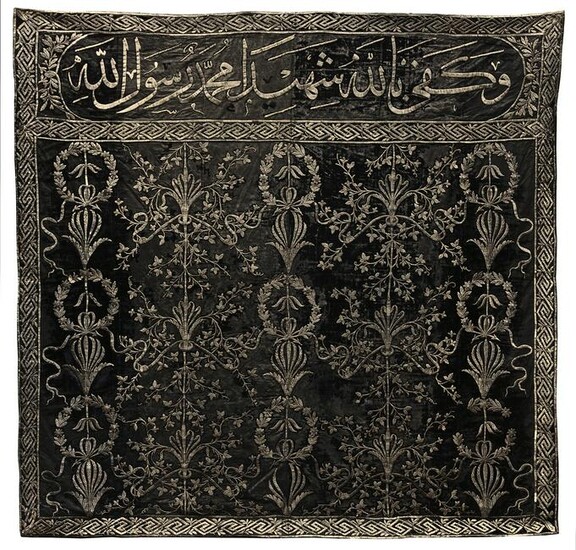A HIGHLY IMPORTANT AND RARE OTTOMAN CURTAIN, EARLY 16TH
A black silk satin curtain embellished with heavily padded silver gilt embroidery.
Rebacked on beige linen.
Although dating of textiles can be a difficult matter, we can accurately date this curtain to the period of Selim I (1512 - 1520 AD) due to the fact that it is one of possibly 3 curtains presented by Yavuz Sultan Selim to the Grand Mosque of Bursa. It is an important political document of the passage of the Caliphate, which was the conquest of Egypt by Yavuz Sultan Selim in 1517. In 2018 one of the matching curtains was restored by the Bursa Metropolitan Municipality.
Overall the decoration is typical of the 16th century with predominately floral designs. The border of the textile is decorated with a geometric pattern embellished with leaves and dividing the calligraphic section at the top from the ornate decoration of the textile. The main section is decorated with 5 alternating vertical band of floral decoration.
In Bursa, Turkey, the most prominent landmark and mosque is ‘The Grand Mosque of Bursa’. This mosque is 600 years old and one of Islam’s most famous sanctuaries. Ulu Cami is the largest mosque in Bursa, the first capital of the Ottoman Empire, and a landmark of early Ottoman architecture which used many elements from the Seljuk architecture. Ordered by Sultan Bayezid I, the mosque was designed and built by architect Ali Neccar in 1396–1399. Bayezid I was the fourth ruler of the Ottoman empire and ruled during the most disastrous period of its decline, which makes ‘The Grand Mosque’ even more significant. Although it was built during the decline of the Ottoman Empire, the Mosque was meant to be an ancestral keepsake for the generations to come.
When Bayezid II (1481 - 1512 AD) was enthroned upon his father’s death in 1481, he first had to fight his younger brother Cem Sultan, who took Inegöl and Bursa and proclaimed himself Sultan of Anatolia. After a battle at Yenişehir, Cem was defeated and fled to Cairo. The very next year he returned, supported by the Mameluks, and took eastern Anatolia, Ankara and Konya but eventually he was beaten and forced to flee to Rhodes.
During his reign, Selim I (so called Yavuz, the Grim) was able to expand the empire’s borders greatly to the south and east. At the Battle of Chaldiran in eastern Anatolia in 1514, Ottoman forces under Sultan Selim I won a decisive victory against the Safavids, ensuring Ottoman security on their eastern front and leading to the conquest of eastern Anatolia and northern Iraq.
300 by 290 cm.
View it on
Sale price
Estimate
Time, Location
Auction House
A black silk satin curtain embellished with heavily padded silver gilt embroidery.
Rebacked on beige linen.
Although dating of textiles can be a difficult matter, we can accurately date this curtain to the period of Selim I (1512 - 1520 AD) due to the fact that it is one of possibly 3 curtains presented by Yavuz Sultan Selim to the Grand Mosque of Bursa. It is an important political document of the passage of the Caliphate, which was the conquest of Egypt by Yavuz Sultan Selim in 1517. In 2018 one of the matching curtains was restored by the Bursa Metropolitan Municipality.
Overall the decoration is typical of the 16th century with predominately floral designs. The border of the textile is decorated with a geometric pattern embellished with leaves and dividing the calligraphic section at the top from the ornate decoration of the textile. The main section is decorated with 5 alternating vertical band of floral decoration.
In Bursa, Turkey, the most prominent landmark and mosque is ‘The Grand Mosque of Bursa’. This mosque is 600 years old and one of Islam’s most famous sanctuaries. Ulu Cami is the largest mosque in Bursa, the first capital of the Ottoman Empire, and a landmark of early Ottoman architecture which used many elements from the Seljuk architecture. Ordered by Sultan Bayezid I, the mosque was designed and built by architect Ali Neccar in 1396–1399. Bayezid I was the fourth ruler of the Ottoman empire and ruled during the most disastrous period of its decline, which makes ‘The Grand Mosque’ even more significant. Although it was built during the decline of the Ottoman Empire, the Mosque was meant to be an ancestral keepsake for the generations to come.
When Bayezid II (1481 - 1512 AD) was enthroned upon his father’s death in 1481, he first had to fight his younger brother Cem Sultan, who took Inegöl and Bursa and proclaimed himself Sultan of Anatolia. After a battle at Yenişehir, Cem was defeated and fled to Cairo. The very next year he returned, supported by the Mameluks, and took eastern Anatolia, Ankara and Konya but eventually he was beaten and forced to flee to Rhodes.
During his reign, Selim I (so called Yavuz, the Grim) was able to expand the empire’s borders greatly to the south and east. At the Battle of Chaldiran in eastern Anatolia in 1514, Ottoman forces under Sultan Selim I won a decisive victory against the Safavids, ensuring Ottoman security on their eastern front and leading to the conquest of eastern Anatolia and northern Iraq.
300 by 290 cm.



